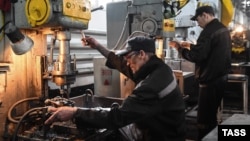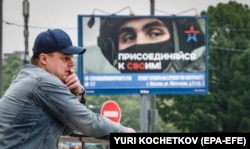Far from the glittering glass skyscrapers, sprawling boulevards, and swanky restaurants of Moscow and St. Petersburg, out in Russia’s often neglected regions, something important is happening.
There’s the toll of death and mutilation for hundreds of thousands of Russian men sent off to fight in the war against Ukraine. Poor regions like Tyva, Buryatia, and Chuvashia have suffered disproportionately.
But men keep signing up to fight, drawn by extraordinarily high wages. That also goes for well-above-average wages at defense factories working full-tilt to churn out tanks, guns, bullets, and other gear.
And those wages -- plus death benefits for widows and children, and compensation for the wounded -- are flooding into regions, fattening bank accounts, and jolting local economies in a way not seen possibly since the Soviet collapse -- this time for the better.
“There is a restructuring ongoing, from west to east,” said Ekaterina Kurbangaleeva, a Russian political scientist now living outside the country. “The country has undergone a major restructuring…turning to the east and that’s where the streams [of money] are flowing.”
“The two-headed eagle, it’s now beginning to look in a different direction,” she said in an interview, referring to Russia’s state emblem.
“Some sectors and some regions have been winners in Russia’s new war-oriented economy,” according to a paper published last month by the London-based Center for Economic Policy Research. “This is especially true for some of Russia’s poorest regions, where the war has offered many people upward social mobility that was not available in the preceding decades of Russia’s reintegration into [the] global economy.”
What’s resulted isn’t just economic. It’s also political, buttressing support for the war despite the toll: more than 315,000 dead and wounded, according to U.S. estimates. British estimates put the toll closer to 500,000.
And for Russians who revile the millionaires who emerged overnight in the chaotic 1990s or those who have benefited less from the growth in prosperity in the 2000s, it’s added to a sense of righting past wrongs.
“A large-scale redistribution of resources in favor of the less well-off has prompted a widespread shift in perceptions of justice for the first time since 1990,” Denis Volkov, the director of the Levada Center polling organization, wrote.
Peace, Land, And Bread
During his 25-year tenure, President Vladimir Putin built his popularity in large part on the prosperity the country saw in the 2000s, as Russia expanded its oil and gas exports and rode the wave of high global prices.
The growth created a genuine middle class, but the prosperity was uneven, largely concentrated in the country’s traditional centers of wealth, Moscow and St. Petersburg, and to a lesser degree in regional cities like Yekaterinburg or Novosibirsk. The Kremlin stuffed its national “rainy-day fund” coffers with excess revenues.
The economy was knocked off kilter by the 2008 global economic crisis, and then six years later, by Western sanctions, imposed after the Kremlin annexed Ukraine’s Crimea Peninsula.
The Kremlin has tried to spur investment in the distant hinterlands, with Putin launching a six-year, $400 billion effort in 2019 called the National Projects, targeting areas including education, health care, science, roads, and other infrastructure.
The jury is out on their impact.
Then came the all-out invasion of Ukraine in February 2022.
War: What Is It Good For?
What the Kremlin and military commanders anticipated would be a quick rout turned into a grinding slog in the face of determined, capable, and Western-armed Ukrainian forces.
In September 2022, Putin announced the first mobilization of the war, drawing in 300,000 men -- mainly reservists -- to replenish serious troop losses. Military recruiters also began hiking wages and benefits for volunteer soldiers, as did private military companies like the now-defunct Wagner Group.
With the recognition that the Ukraine conflict was becoming a long war, the Kremlin also retooled large parts of the industrial economy, to arm and equip Russian forces.
In August 2022, the average wage across Russia was around 62,000 rubles a month ($700 in today’s dollars). But in poorer regions, wages were markedly lower in some cases, according to research by the Bank of Finland’s Institute for Emerging Economies. In the North Caucasus, the average monthly wage in 2022 was just 35,000 rubles. ($400).
Signing bonuses for men volunteering to fight in Ukraine, meanwhile, have been climbing toward 700,000 rubles ($7,860 in today’s dollars) -- more than an entire annual salary for many men.
Under a March 2022 decree signed by Putin, soldiers injured on the battlefield receive 3 million rubles ($33,700 in today’s dollars) in compensation; families of killed soldiers, meanwhile, receive 5 million rubles. Both are princely sums, particularly in lower-cost regions of Russia.
By paying high wages for fighters, the Kremlin has avoided what would be a deeply unpopular second round of mobilization. Putin himself bragged about how many volunteers were signing up to fight during an economic conference last week.
“Instead of strict mobilization, the government is paying huge amounts of money to those who signed military contracts,” Kurbangaleeva said.
One 21-year-old woman from Cheboksary, the capital of the Volga River region of Chuvashia, said her brother was reported killed in early April near Avdiyivka, a focus of heavy fighting in Ukraine. She said her sister-in-law, now a single mother of two young children living in a village outside Cheboksary, had been told to expect 5-million-rubles ($56,000) in compensation for her husband’s death.
“They were never particularly luxurious – they lived modestly, and never went to any resorts or on vacation,” the woman, who did not want her name published for fear of repercussions, told RFE/RL’s Tatar-Bashkir Service. “They saved and saved. There was money, but it was never enough, so my brother went to fight. He went there because of the money. Where can you earn money like that in Chuvashia?”
Russia also now counts some 6,000 military-industrial factories and related enterprises, a threefold increase from before the 2022 invasion, according to Elina Ribakova, senior fellow at the Peterson Institute for International Economics and senior director at the Kyiv School of Economics.
More than 3.5 million people work in those factories, manning around-the-clock shifts and six-day workweeks.
Salaries, meanwhile, have increased from 20 to 60 percent since the invasion, Ribakova said in an article published by the Financial Times. Moreover, many companies offer exemptions from being sent to fight in Ukraine.
One illustrative example, Kurbangaleeva said, was for a low-skilled seamster or seamstress working in a factory: In late 2021, he or she might have a monthly salary of 15,000-20,000 rubles; now salaries run around 120,000-130,000 rubles.
Pavel Luzin, an expert on the Russian military and defense industry, said he doubted the income flowing to poorer regions was creating fundamental change in local economies.
If anything, he said, it is fueling inflation, which stood at 7.3 percent last year, and is projected to exceed 5 percent this year.
“Payments for [war] losses are not being transformed into the financial capital,” he told RFE/RL. “Money is just spent to cover bank loans and urgent needs of family members -- for instance, parents -- for the purchase of apartments or building…houses, for purchase of cars and so on. Among other things, these payments contribute to the high monetary inflation all around Russia.
Still, the ongoing distribution of wealth might be compared -- inversely -- to what happened in the 1990s, when high inflation, privatization, the plummeting ruble, and systemic disruptions sucked prosperity out of Russia’s provinces, said Laura Solanko, a Bank of Finland researcher.
“But if we think about the Putin era, nothing comparable easily comes to my mind,” she told RFE/RL.
Is It Sustainable?
The flow of wages and benefits to poorer regions has not only spurred a burst of economic activity on a local level; it’s also effectively bought support for continuing the Ukraine war, experts said.
“For Russia’s citizens, the decision to support the war is no longer merely influenced by political rhetoric and propaganda; it is now also driven by pragmatism,” Kurbangaleeva wrote in an article for the Carnegie Endowment for International Peace.
“The sense of normalcy is largely ensured by socio-economic stability, which the state has devoted considerable resources to maintain,” Volkov, of the Levada Center, wrote in his own piece for Forbes.
The bigger question is: is it sustainable, say, if the war ends tomorrow?
Andrei Yakovlev, a Russian economist and associate fellow at the Davis Center for Russian and Eurasian Studies at Harvard University, said demobilized soldiers would expect continued high wages, as would well-paid factory workers in the event that defense-plant production was scaled back.
“From a political point of view, it can be dangerous for the Kremlin,” he told RFE/RL. “It [would] be cheaper for the Kremlin to keep all the soldiers on the front line. Because if they will come back to Buryatia, Chuvashia, and face again much lower salaries…. there are no comparable incomes, which [could] be provided for these people in the regions.”
“As they say in Russian,” Kurbangaleeva said, “For some war is hell, for others it pays well.”


